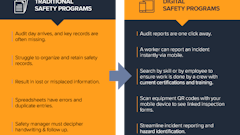
Almost every pavement maintenance contractor will be adding to their employee count by hiring new workers this year. It is incredibly important that those contractors set the pace and expectations they desire for the new worker.
How a new worker is assimilated into the crew, that is, made to feel like one of the crew members is key to their staying with the contractor. So it is in this spirit that I want to share nine key steps to start that “on-boarding” effort that keeps new workers longer.
Step 1. Call the New Worker BEFORE They Start
It’s amazing what this brief call can do to inspire new workers to show their first day. This call should welcome the worker to the company, remind them of when to arrive, what clothing they are to work in, and confirm they have a way to get to work. Keep it upbeat and friendly and provide them with the chance to ask questions. Ideally, the Owner, or the new worker’s immediate leader should make this call.
Step 2. Meet & Greet New Worker on Their 1st Morning
Have someone looking out for this new worker’s arrival and have them take the new worker around to meet the other crew members. Make sure to use the new worker’s name as you introduce them. The foreman should take just a few minutes to assess that the new worker has the needed safety wear and then explain what his expectations are for the new worker and that’s it’s OK “not to know everything.”
Step 3. Explain the Morning Routine
This primarily involves demonstrating what it takes to get ready to leave the yard each morning and what his early role will be as he begins his work. It’s important that new workers are given work that they can begin to execute daily as this will make them feel like part of the team.
Step 4. Talk to the New Worker on the Drive to the Job Site
A continuation of getting to know the worker should be exercised on the drive to the job site. Asking the new worker how they may have completed work at their last employer and giving the worker an idea about what will be done on today’s job site. It’s important to have some conversation while on the ride as it provides you, and other workers, the chance to better understand this new worker’s work ethic, experience, drive, likes, dislikes, etc.
Step 5. Explain the Purpose of Stretching and the AM Huddle
Not every contractor takes five minutes for workers to stretch so your new worker may never have performed morning stretches before. If your crew normally does not take the time for stretching, this will be a good excuse to start. It’s healthy, gets the blood pumping, and is a proven positive on reducing minor strains and sprains.
Step 6. Conduct Your AM Crew Huddle
This is a “stand-up” meeting, maybe while you are also stretching, that lines out the day’s work, directing workers to who will be doing what and where. It’s also a good time to allow all the workers to ask questions about the day’s efforts, when is material to arrive, and what amount of work needs to be completed for the day. Any issue related to the project needs to be shared as a reminder, i.e. reminder to keeping the site clean, expectations of the client, limiting the rough talk as site is next to elementary school, proper use of needed barricades, safety tape, etc.
Step 7. Practice a “4 – Quarter” Overview Throughout the Workday
Good idea anyway, but especially if you have a new worker. Take a stroll around the work site at least every sixty to ninety minutes. This works out to be about four times a day to see how work is progressing and what needs the new worker has that can be quickly addressed. If training is needed, use the following process: 1. Explain; 2. Demonstrate; 3. Observe; 4. Offer Feedback.
Step 8. Afternoon PM Crew Huddle
This should always be completed just prior to leaving the jobsite for the day, after all equipment and tools are squared away. A brief review on the day’s work, issues with quality, safety, equipment, tools, etc. should be updated with discussions about “What we might have done different, better?” Also, encourage the workers and finally, it would be smart to confirm who will be at work tomorrow.
Step 9. Closing Out the Day Before the New Worker Leaves (At the yard)
It’s always good to leave your workers feeling good when they leave and especially for the new worker. Stop them just long enough to ask them how their day went, what they learned, and what can you do for them. This may sound unnecessary, but it actually can go a long way to influencing the new worker that you do want them to learn and to improve.
The three primary reasons new workers often leave their contractors sooner rather than later is first, that no one is talking to them, second, that no one is training them on learning a skill or task, and three, no one is following up with them to see how they are doing. Use the nine steps listed above and you will be off and running with winning new workers over to your leadership.




















